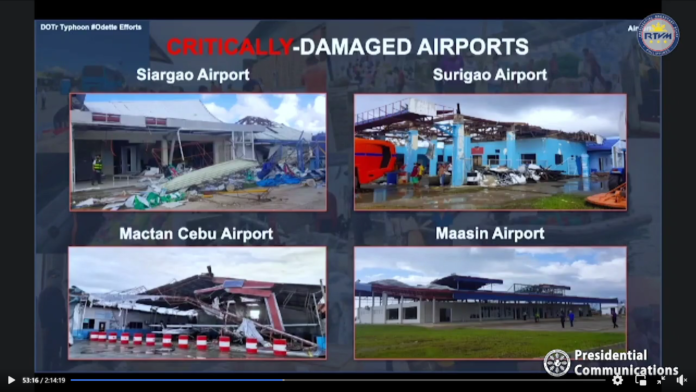
-
Typhoon Odette damaged 24 airports and 160 ports nationwide
-
Of the 24 airports, nine sustained major damages, including the critically affected Siargao Airport, and 15 had minor impairments
-
Of the 160 affected ports, 126 are already fully operational, 25 partially operational, and nine critically damaged
-
The Philippine Coast Guard has helped evacuate more than 1,500 families and has transported 393 tons of relief goods so far
Twenty-four airports and 160 ports nationwide sustained damages from Typhoon Odette, according to Transportation Secretary Arthur Tugade.
Of the 24 airports, 15 sustained minor damages, eight had major ones, and Siargao Airport was critically damaged, Tugade said during a Malacañang briefing on December 27.
With minor damages are the airports in Busuanga, Puerto Princesa, Bicol, Caticlan, Kalibo, Roxas, Bohol, Panglao, Tacloban, Ormoc, Laguindingan, Cotabato, Davao, General Santos, Butuan, and Iloilo.
Airports with major damages: San Vicente, Dumaguete, Camiguin, Siquijor, Antique, Maasin, Surigao, and Mactan in Cebu.
Despite the damages, Tugade said airports can still operate while being repaired. Airports with minor damages resumed operations following Typhoon Odette’s exit, while as of December 24, the eight airports with major damages also resumed operations but with limited capacity. Critically struck Siargao Airport is set to be operational on December 28.
Tugade said P13.5 million is needed to repair Siargao Airport; P10.5 million for Surigao Airport; P3.750 million for Maasin Airport; and P2 million for Mactan-Cebu International Airport.
On the maritime side, Tugade said that of the 160 affected ports, 126 are already fully operational, 25 partially operational, and nine critically damaged. Critically damaged are those in Maasin, San Ricardo, San Francisco, San Juan, Getafe, Tapal, and Talibon.
Typhoon Odette also affected 40 shipping routes and damaged 45 ships. Immediately after the typhoon left, 65 ships resumed operations compared to 119 ships serving prior to the typhoon’s landfall. Nine ships have been granted a special permit to operate, while an additional eight ships are required for relief/transport operations.
Meanwhile, Tugade said the Philippine Coast Guard (PCG) became the “vanguard and frontliner” of the transport department, providing relief and rescue operations during and after Typhoon Odette’s onslaught. PCG has helped evacuate more than 1,500 families and transported 393 tons of relief goods. Tugade said Coast Guard commandant Leopoldo Laroya is preparing vessels to transport construction materials for shelter as well as other relief goods.
Typhoon Odette, the strongest typhoon to hit the Philippines this year, made landfall on December 14, battering the Visayas, Mindanao and parts of Luzon before leaving the Philippine Area of Responsibility on December 18.




